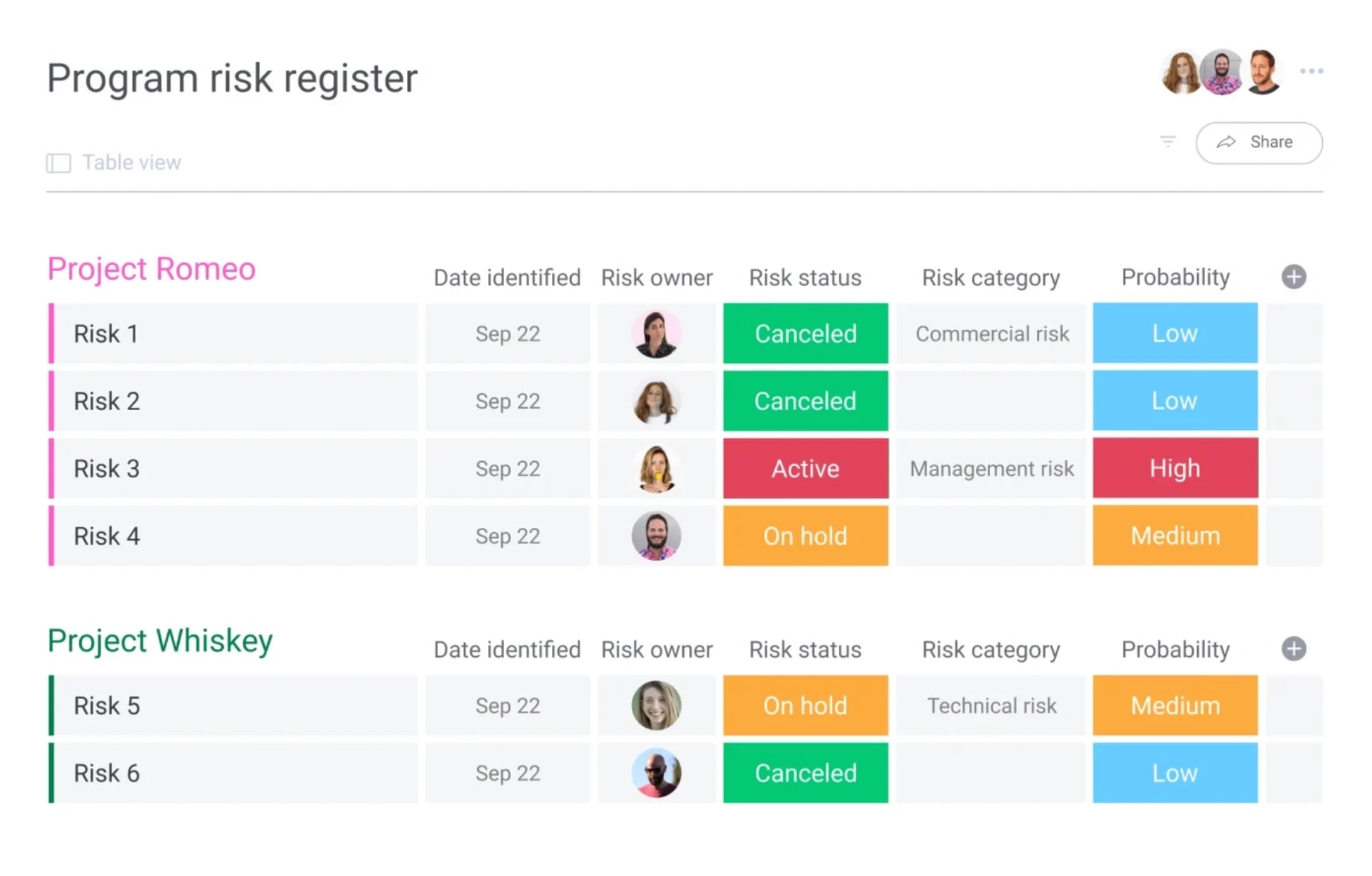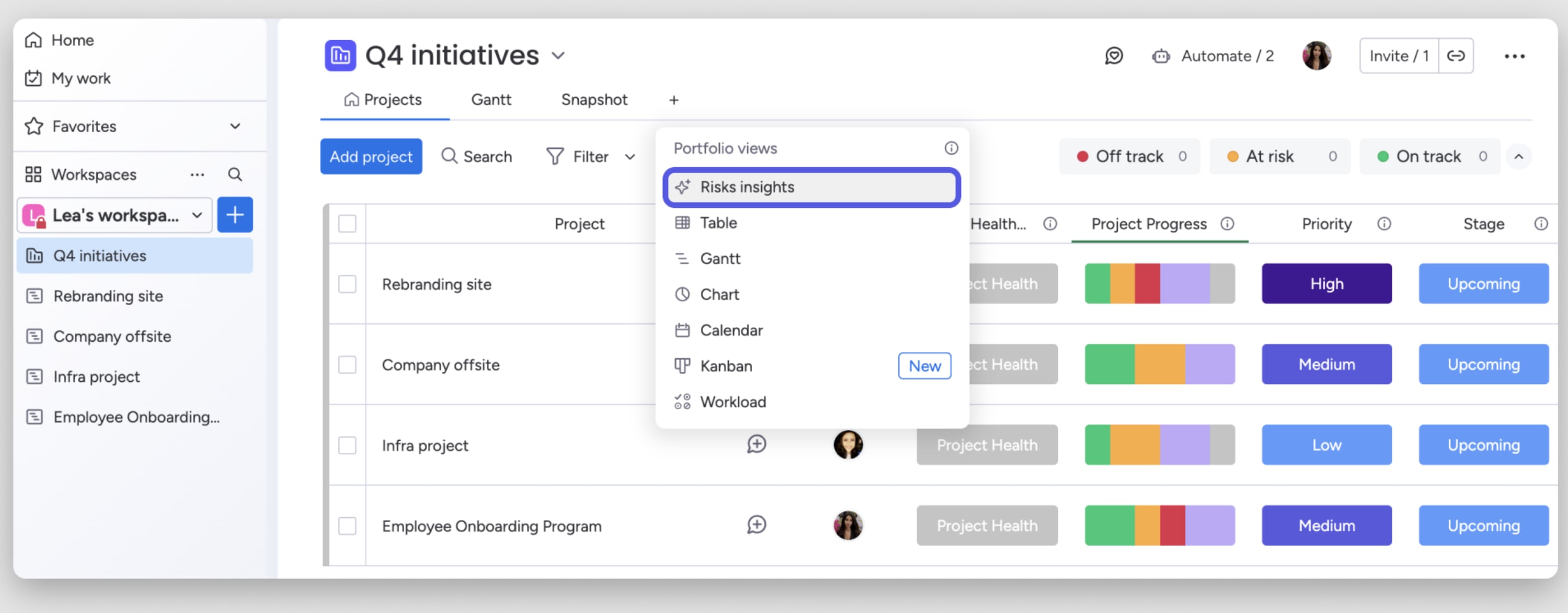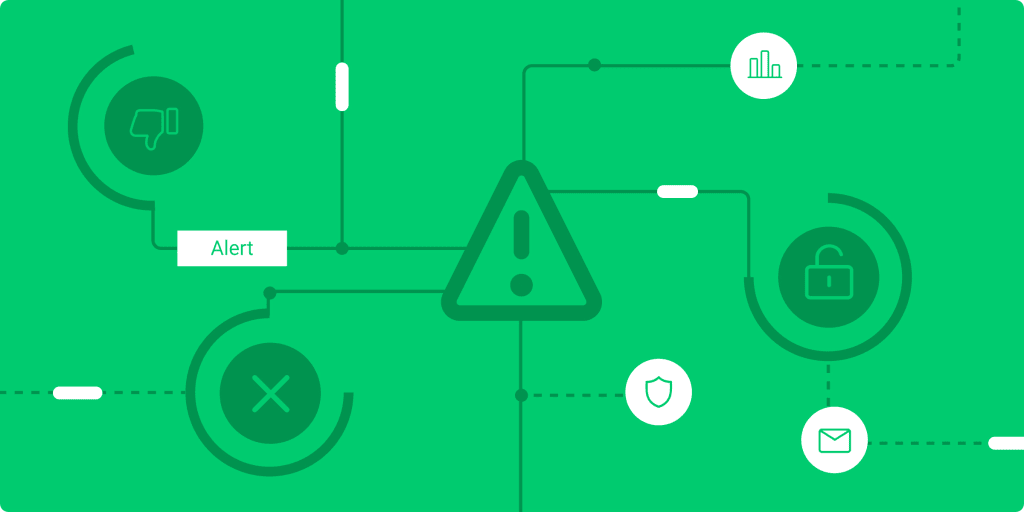Every project manager has heard the words “risk” and “issue,” but they’re not interchangeable. A risk is something that might happen — like a vendor delay or a budget overrun. An issue is something that’s happening right now and disrupting your project.
Knowing the difference and how to handle each is critical to keeping projects on track.
In this guide, we’ll break down risk vs issue with clear definitions, examples, and practical tools like risk registers and issue logs. You’ll also see how modern AI-powered project management platforms — including monday work management — can help you spot risks early and respond to issues fast.
Try monday work managementKey takeaways
- Risks are about what could happen in the future, while issues are problems you’re facing right now.
- Poor management of risks and issues is a leading cause of project failure.
- Track both risks and issues with a risk register for what might happen and an issue log for what’s happening now.
- AI-powered insights help spot problems early and give teams time to take action before risks become issues.
- Regularly reviewing risks and issues helps you catch warning signs before small problems grow bigger.
What is the difference between a risk and an issue?
We’ve defined risks as future possibilities and issues as present problems — but how does that difference affect your day-to-day project management? Here’s how they diverge when it comes to timing, certainty, response strategy, and impact:
| Factor | Risks | Issues |
|---|---|---|
| Timing | Possible events in the future Example: Our vendor might deliver late | Problems happening right now Example: Our vendor missed the delivery date |
| Certainty | Uncertain probability — maybe 10%, maybe 70% | Certain probability — 100% |
| Response | Needs planning, preparation, and a contingency plan | Needs immediate action to resolve and requires damage control |
| Impact | Can be positive (opportunity) or negative (threat) | Always negative, causing disruption or harm |
| Documentation requirement | Risk register that includes what might happen, how likely it is, and what happens if it occurs | Issue log that includes what's wrong, who is fixing it, and when it will be resolved |
What is a risk in project management?
A risk in project management is any uncertainty that could affect your project if it happens. This means it hasn’t occurred yet, but you need to watch for it and have a plan ready.
There are two types of risks:
- Positive risks (opportunities) could help your project, such as finishing early or under budget
- Negative risks (threats) could hurt your project, such as delays or cost overruns
Every project faces common risks that experienced managers watch for. Here are some examples:
- People risks: Your best developer might quit mid-project.
- Technology risks: That new software might not work with your existing systems.
- External risks: A supplier could deliver late and delay everything.
- Budget risks: Unexpected costs could blow your budget.
- Market risks: New regulations might force you to change your approach.
What makes something a risk? It has specific characteristics you can recognize. First, it hasn’t happened yet — it’s a possibility, not a reality. Second, you can measure how likely it is to occur and how much damage it could cause. Third, you can do something about it through planning.
With smart software like monday work management, teams can spot these risks early through pattern recognition and automated alerts, giving you time to prepare before problems strike.

What is an issue in project management?
An issue in project management is a problem that’s actively disrupting your project right now. This means it’s not theoretical — it’s real and it needs immediate attention to keep your project moving forward.
Issues demand action because they’re already causing damage. Maybe your budget is blown, your timeline is slipping, or quality is suffering. Whatever the problem, you can’t wait to address it.
Real project issues look like everyday fires you need to put out. For example:
- Budget issues: You’ve already spent 20% more than planned.
- Resource issues: Your lead designer called in sick during launch week.
- Technical issues: The server crashed and nobody can access project files.
- Quality issues: Testing revealed major bugs that need fixing before release.
- Scope issues: The client wants major changes halfway through the project.
Issues share common traits that make them urgent. They’re happening now, not tomorrow. They’re definitely real — no probability calculations needed. They require immediate response to prevent further damage.
Teams using monday work management can flag issues instantly, assign owners for resolution, and track progress until problems are solved — turning chaos into controlled response.
5 types of risks that can transform into project issues
Some risks have a nasty habit of becoming issues. Recognizing these patterns helps you prepare more effective responses when risks materialize.
1. Technical risks
Technical risks involve anything that could go wrong with your technology, systems, or technical approach. These often catch teams off guard because technology can fail in unexpected ways.
When that risk of “the integration might not work” becomes “the integration failed and nothing is syncing,” you’ve got an immediate technical issue. Your team needs to either fix the integration, find a workaround, or change your technical approach entirely.
2. Resource and capacity risks
Resource risks center on having the right people, skills, and tools when you need them. These risks are especially common in organizations juggling multiple projects.
The risk that “we might lose a key team member” becomes an issue when that person actually resigns, a threat amplified by the fact that 40% of employees want leadership development opportunities to secure their career growth, according to The world of work report by monday.com. Suddenly you’re scrambling to redistribute work, find replacements, or adjust timelines to accommodate the loss.
3. External market risks
External risks come from outside your organization — things you can’t control but must respond to. Market changes, new regulations, or vendor problems all fall into this category.
When “new regulations might affect our product” becomes “new regulations just passed and we’re non-compliant,” you have an urgent issue. Your project scope might need major changes to meet legal requirements.
4. Organizational change risks
Internal changes create risks that can derail projects. New leadership, restructuring, or strategic shifts can all impact your project’s priority and resources.
That risk of “leadership might change priorities” becomes an issue when new executives actually redirect your budget to other initiatives. Now you need to either secure new funding or scale back your project.
5. Communication risks
Poor communication amplifies every other risk. When teams don’t share information effectively, small problems grow into major issues — a common challenge in large enterprises where only 61% of employees in large enterprises are satisfied with transparency.
Communication risks become issues when misunderstandings lead to wrong deliverables, missed deadlines, or stakeholder disappointment. These issues often require rework and relationship repair.
Software like monday work management addresses these risk categories through centralized communication and automated updates, helping teams catch problems before they escalate.
Try monday work managementHow effective risk and issue management prevents project failure
When you don’t manage risks and issues well, projects spiral out of control. Small problems compound into bigger ones, creating a domino effect that’s hard to stop.
Unidentified risks become surprise issues that blindside your team. Without warning or preparation, these surprises force reactive decisions made under pressure. Quality suffers when speed becomes the only priority.
What happens when multiple issues hit at once? Teams enter crisis mode, jumping from fire to fire without strategic direction. Resources get stretched thin. Morale drops as stress levels rise. Deadlines slip while costs balloon.
The value of effective management extends beyond the immediate project:
- Financial impact: Emergency fixes cost more than planned prevention
- Team burnout: Constant firefighting exhausts your best people
- Reputation damage: Repeated failures erode stakeholder trust
- Lost opportunities: Crisis management leaves no time for innovation
How do you break this cycle? Start by acknowledging that reactive management is unsustainable. Then build systems that help you see problems coming, like a risk register and issue log.
Risk register vs issue log

A risk register and issue log work together but serve different purposes. Understanding when to use each helps you maintain control throughout your project.
- A risk register is your early warning system. It captures things that might go wrong, estimates their likelihood and impact, and documents your prevention plans. Think of it as your project’s insurance policy — you hope you won’t need it, but you’re prepared if you do.
- An issue log is your active problem tracker. It documents what’s currently broken, who’s responsible for fixing it, and progress toward resolution. This becomes your single source of truth when things go wrong.
Key differences in how you use each document:
| Aspect | Risk register | Issue log |
|---|---|---|
| Timing | Looks ahead and records potential problems | Focuses on the present and tracks current problems |
| Updates | Reviewed periodically (weekly or biweekly) | Updated daily as issues arise and are resolved |
| Ownership | Risk owners monitor and proactively manage | Issue owners lead resolution efforts |
| Metrics | Focuses on probability and potential impact | Tracks resolution time and closure progress |
The magic happens when these documents work together. As risks materialize into issues, they move from one document to the other, maintaining continuity and accountability.
How AI improves risk and issue management

Modern AI technologies are transforming how teams manage risks and issues by moving from reactive to truly proactive project management. Here are some of the key AI capabilities making a difference:
- Predictive analytics: AI automatically analyzes past project data to forecast where issues are most likely to arise. This gives teams a heads-up so they can take preventive action before small risks snowball into major roadblocks.
- Anomaly detection: Smart systems flag anything out of the ordinary, like unexpected delays, cost spikes, or unusual resource usage. With real-time alerts, teams are notified the moment something drifts from the plan—often before it turns into an active issue.
- Natural Language Processing (NLP): AI scans project updates, meeting notes, and communications to spot early warning signs and subtle risk signals that humans might miss. For example, if several team members mention “delays” or “uncertainty” in status updates, the system can highlight these as emerging risks.
- Smart recommendations: AI does more than identify problems; it suggests the best next steps or mitigation strategies based on what’s worked for similar projects. If an issue pops up, the system might recommend a playbook, assign the right owner, or even automate parts of the response.
With monday work management, these AI-powered insights are built in. Teams can see predictive risk scores, receive early warnings, and get personalized guidance to stay ahead of problems.
Try monday work managementReal examples of risks becoming issues in project management
Let’s look at how risks can transform into issues in hypothetical — yet seated in reality — projects. These examples show the warning signs and transition points you need to watch.
Budget risk becomes budget issue
Your team identifies that complex features might require extra development time. You estimate a 30% chance of needing additional budget. Two months later, when features prove more complex than expected, you’re facing actual overspending. The risk is now an issue requiring immediate decisions about scope or funding.
Resource risk becomes resource issue
You know your lead developer has been interviewing elsewhere — there’s risk they might leave. When they actually submit their resignation during a critical phase, you have an immediate issue. Work must be reassigned, knowledge transferred, and timelines adjusted.
Technology risk becomes technology issue
During planning, you flag that a new platform might not support all required features. When testing reveals critical functionality gaps, this risk transforms into an issue that could derail your entire technical approach.
Vendor risk becomes vendor issue
Based on past performance, you identify the risk that your supplier might deliver late. When they actually miss their deadline by two weeks, every dependent item in your project gets pushed back. You need immediate replanning.
Transform your risk and issue management process

Great risk and issue management isn’t about being perfect — it’s about taking steady steps to get better, project by project. You don’t have to overhaul everything overnight. Just start with what you have, and build from there.
Make risk reviews a regular part of your workflow. Set a weekly or bi-weekly time to check in as a team: what new risks do you see? What issues have cropped up? The more routine this becomes, the less likely you’ll be surprised later on.
Here are some tips:
- Spot risks early: Build risk checks into your planning, not just after things go sideways.
- Assign clear owners: Make sure every risk and every issue has a person responsible for watching and acting on it.
- Set clear triggers: Know exactly what signals a risk has turned into an issue, so you can act fast.
- Keep escalation simple: Make it easy for your team to flag urgent problems and get help quickly.
- Learn and adapt: Look back at what happened, learn from it, and update your approach for next time.
Smart technology makes a difference — AI can spot patterns and flag early warning signs, but it still takes humans to make the right calls and take action. With monday work management, you get the best of both: AI-powered insights with humans in the loop, so you can catch problems early and decide how to tackle them as a team.
Remember, you’ll never get rid of every risk. The real win is being ready and knowing you have the tools and teamwork to handle whatever happens.
Try monday work management
FAQs
What is the main difference between a risk and an issue in project management?
A risk is a potential problem that might happen in the future, while an issue is an actual problem happening right now. Risks require planning and prevention, but issues need immediate action to resolve.
How do you know when a project risk has become an issue?
A risk becomes an issue when it transitions from possibility to reality. The key indicator is when you stop saying "this might happen" and start saying "this is happening now and affecting our project."
Should project teams track both risks and issues simultaneously?
Yes, teams should track both throughout the project lifecycle. While resolving current issues, you must continue monitoring potential risks to prevent future problems from catching you off guard.
What's the difference between a risk register and an issue log?
A risk register documents potential future problems with their likelihood and mitigation plans. An issue log tracks current problems that need immediate resolution, including owners and target fix dates.
Who should be responsible for managing project risks versus issues?
Project managers typically oversee both, but they delegate specific responsibilities. Risk owners monitor potential problems and implement prevention plans, while issue owners take charge of resolving current problems.
How frequently should teams review their project risks and issues?
Review issues daily since they need immediate attention. Review risks weekly or bi-weekly depending on project complexity, ensuring you catch early warning signs before risks become issues.
